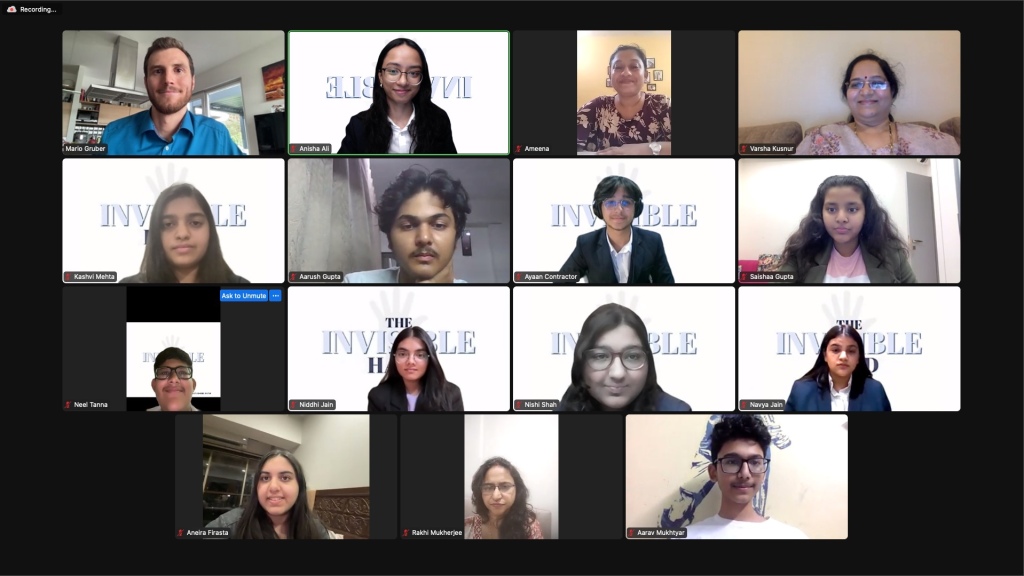The team of PPSIJC’s Economics club, The Invisible Hand, were eager to put what they had learnt into action and contribute towards sustainable development. Therefore, to make a positive difference, they came up with the ‘Invironmental’ initiative.
“We realised that in our own communities economic progress and environmental protection is often seen as mutually exclusive while it can, and it should be mutually reinforcing,” said the club’s creative head, Ayaan Contractor. They wish to encourage small, more environmentally friendly changes that could create a big impact. For example, the club doesn’t print out posters and makes sure to save paper wherever possible.
Recently, they got a unique opportunity to interact with renowned environmentalist- Dr. Mario Gruber; an independent consultant in London’s most productive boroughs- Lambeth Council and Westminster City Council.
In conversation with Dr Gruber, the club’s president Anisha Ali asked how PPSIJC students, and young people in general could contribute to fostering sustainable economic growth and he provided actionable steps, emphasizing that innovation often involves implementing existing ideas. He suggests focusing on impactful actions like adopting renewable energy sources, making changes to our diet and transitioning to electric vehicles. Dr. Gruber encourages engaging with adults and discussing sustainability’s positive impact on both the environment and the economy. He highlights the overlap between environmental benefits and economic gains, urging young people to communicate this to individuals, companies, and local policy makers. He underscored the importance of presenting evidence, collaborating with businesses and policy makers, and advocating for sustainable strategies. He also pointed out that these efforts can multiply knowledge and one person’s actions can greatly influence others, ultimately leading to positive change.
Furthermore, he explains that sustainability and the economy are no longer mutually exclusive; they complement each other. Legislation to reduce carbon dioxide emissions drives efficiency and innovation in factories and energy production. This shows that sustainability is beneficial for the economy. However, the challenge lies in a complex system issue where various components need to align simultaneously for sustainable practices to take hold. For instance, consumers wanting photovoltaic panels would require companies to invest in training and funding. This interconnectedness creates challenges with timing and coordination. Mario Gruber’s research focuses on these complexities and he specializes in consulting London boroughs on such sustainability issues.
More specifically, he explains how his research focuses on the adoption and diffusion of sustainable practices to drive economic growth. He highlights the interconnectedness of sustainability, economic benefits, health, and ethical concerns. Mario identifies consumer behavior as a significant bottleneck in achieving sustainable economic development. Consumers often face challenges in adopting sustainable products due to habits, cultural factors, and concerns. His research merges various theories on adoption and innovation, including the concepts of early adopters and the S curve of adoption. By understanding and addressing consumer adoption patterns, policy-makers and companies can accelerate the transition to sustainable practices, ultimately benefiting both the economy and the environment.
As the interviewer, Anisha Ali acknowledges Dr. Gruber’s use of an interdisciplinary approach in his research and asks why he feels the importance of using such an approach. Mario Gruber responds by emphasizing the importance of interdisciplinary thinking in today’s world. He mentions that economics can provide foundational knowledge, but practical skills, such as computer programming and people management, become crucial later on. He explains that economic issues often transcend their field and become psychological, policy, or legal issues. Mario’s research allowed him to identify crucial factors, their timing, and their interactions, helping him pinpoint the most important issues and knowledge gaps. This interdisciplinary approach enabled him to focus on effective solutions that create value and multiplier effects beyond individual projects, benefiting society and the planet.
Anisha Ali goes onto inquire about the applicability of policy interventions and innovations to a developing country like India. To which Dr. Gruber responds by stating that while innovation is important, much of it is about implementation and adapting existing ideas to local contexts. He notes that true cutting-edge innovation is rare and that information about innovations spreads quickly. Regarding India, he suggests looking at historical examples of countries facing similar challenges during their economic growth. He emphasizes the need for specificity in solutions and mentions that what works in one country might not work in another due to differences in skills, problems, firms, and policies.
Most importantly, when asked how young people can contribute to fostering sustainable economic growth in the present, Dr. Mario Gruber responds by offering actionable steps:
Focus on Impactful Actions: Prioritize actions with the most positive impact on the environment, such as adopting renewable energy sources and promoting vegetarianism.
Inform and Educate: Talk to adults, explain the best sustainability practices, and address misconceptions or greenwashing.
Connect to the Economy: Show how environmentally beneficial actions can also drive economic growth and innovation, emphasizing the overlap between environmental and economic benefits.
Engage with Companies: Encourage companies to adopt sustainable practices that are both environmentally friendly and economically profitable.
Engage with Policy Makers: Engage with local policy makers to emphasize the economic and social benefits of sustainable practices, urging them to implement policies that support sustainability.
Moreover, on being asked about the true impact of one person’s actions towards this cause, Dr. Gruber aptly provides numerical context. He states that the planet’s capacity is around 3 tons of carbon emissions per person per year. However, the global average per person is currently 6-10 tons, which means people are emitting more than twice as much as the Earth can handle. He encourages people to assess their energy usage and carbon emissions, and then make conscious efforts to reduce them by adopting renewable energy sources and more sustainable practices.
Lastly, Anisha asks Dr. Gruber about his hopes for the future regarding his work and the creation of a green economy. Mario Gruber shares that he hopes through his models and research, he can demonstrate the accelerated potential of sustainable economic development, showing its benefits for the economy and job creation.
He envisions a future where efforts are consolidated around specific evidence-based solutions that provide the maximum return on investment for the environment, people, and profits. Dr. Gruber emphasizes the importance of the actions taken today, as they will have a significant impact over the next few years. He is hopeful that the acceleration of efforts is already underway.
The audience question and answer session was kicked off by AS Level student, Aarav Mukhtyar’s question, asking Dr. Gruber about his work on the low carbon Lambeth economic resilience policy, which focused on sustainable transport, smart mobility, climate change, and air quality. Mario explains that when working with local governments or companies, it’s essential to align with their interests and priorities. In the case of Lambeth, they analyzed the local priorities such as job creation and skills development, as well as climate and air quality goals. They applied a model to identify the opportunities within the local economy that align with the global market for the green economy. They looked for local companies, products, and services that had comparative advantages and the potential to grow through low carbon and sustainable approaches.
Next, Dr. Gruber responds to Joshua’s question, a student in the A2 keen on pursuing environmental studies. Joshua asked Dr. Gruber what skills and lifestyle changes are necessary to go into such a feild. Dr. Gruber emphasizes the importance of combining environmental studies with other disciplines such as policy, political science, economics, and business management. These combinations make environmental studies even more valuable in the context of the 21st century. In terms of lifestyle, he suggests that it’s important for individuals in environmental studies to integrate environmentally friendly practices into their daily routines. This could include adopting sustainable habits like reducing meat consumption, minimizing air travel, and making choices that have a lower environmental impact. By living a lifestyle that aligns with the principles of environmental sustainability, individuals can better exemplify their commitment to the field.
Moreover, Mario addresses the student’s concerns about the lack of charging facilities for electric vehicles (EVs) in cities like Mumbai due to inadequate power grid infrastructure. He suggests several solutions:
Focus on Public Transport: Instead of relying on individual cars, promoting and improving public transportation can be a more sustainable solution. Public transport systems, if efficient and well-connected, can alleviate the need for personal vehicles in congested cities.
Use of EV Charging Infrastructure: While there might be challenges with EV charging infrastructure, some EV manufacturers like Tesla have addressed this by investing in their own charging networks. This encourages governments and businesses to prioritize grid improvements.
Personal Photovoltaic Panels: For individuals who still wish to use EVs, combining them with personal photovoltaic (solar) panels can be an option. Charging EVs during the day when solar panels generate electricity can help reduce the strain on the power grid.
Behavioral Changes: Emphasizing the need for lifestyle changes and reducing reliance on cars can play a significant role. Encouraging people to reconsider the necessity of owning a car in a city with good public transportation and ride-sharing services can be effective.
Dr. Gruber stresses the importance of not letting excuses hinder the transition to more sustainable transportation options, as small changes in individual behaviors can have a significant positive impact on the environment.
Another student, Toshani Dutta from the A2 was keen on knowing how areas of economics and psychology could overlap in solving complex issues.
Dr. Gruber highlights that these two fields intersect in situations where psychological factors impact economic decisions. To address this, he advises focusing on studying specific theories, topics, and subfields where psychology and economics overlap the most. Regarding policy-making, Dr. Gruber brings up an example from the UK where technology-neutral policies are advocated, allowing the market to determine the preferred technology. He contrasts this approach with countries like Norway, where policies promote electric vehicles through incentives and charging infrastructure. He suggests that understanding the psychological effectiveness of policies and their economic impact can help experts communicate with policy-makers and potentially influence more effective decisions.
Aarush Gupta, a student from the AS level, shared his concern about the high prices of EV’s which turns consumers away from using them.
To address this, Dr. Gruber suggests strategies to change this reluctance in people’s mindsets:
Equality in Price: Countries like Norway have implemented policies that make the price of electric vehicles comparable to petrol or diesel vehicles. This eliminates the cost barrier during the purchasing decision.
Long-Term Savings: Emphasize that while EVs might have a higher upfront cost, they become cheaper to run and maintain over time. Fewer parts require repair, and the cost of electricity is lower than petrol or diesel.
Resale Value: Mention that EVs tend to have better resale value compared to traditional vehicles, contributing to the overall cost-effectiveness.
Environmental Considerations: Highlight the significant environmental and societal damage caused by petrol and diesel vehicles. If people weigh the financial savings against the environmental and societal costs, the adoption of EVs becomes a more responsible choice.
Ethical Reflection: Encourage individuals to reflect on whether saving a few initial thousand dollars is worth the substantial societal, health, and environmental costs associated with traditional vehicles.
By presenting a combination of financial, environmental, and ethical arguments, people might be more inclined to consider electric vehicles as a viable and responsible option.
The last question was asked by an A2 student, Devina, who shared her experience on trying to implement the use of solar energy in her building and the reluctance she was phased with from the elders in her building.
Mario advises Devina to approach the situation with a detailed cost-benefit analysis and present the decision makers in the building with the facts:
- Cost-Benefit Analysis: Devina can calculate the projected costs and benefits of installing solar panels for hot water in her residential building. This includes factors such as the initial installation cost, savings from reduced hot water expenses, and potential resale value.
- Long-Term Payback: Emphasize that while the initial investment might be higher, solar panels generally pay off over time. They typically have a payback period of 7-8 years and continue to provide savings for years afterward.
- Alternative Solutions: Devina might consider looking into photovoltaic panels that generate electricity. This could offer more versatility in energy usage and allow for sharing electricity among the building’s apartments.
- Community Benefits: Highlight the broader advantages of adopting solar technology, such as boosting the local economy, creating jobs, and reducing dependency on imported energy sources.
- Environmental Impact: Explain how embracing solar energy aligns with environmental goals and reduces the building’s carbon footprint. This can appeal to individuals who are conscious of the environment’s health.
- Learning Experience: Emphasize that even if the proposal doesn’t succeed immediately, the effort provides valuable experience and knowledge that can be applied to future endeavors.
These comprehensive approaches to achieving sustainable development provided by Dr. Gruber left the students motivated to make a difference. To conclude, Dr. Gruber stated,
“it’s important for everyone, especially you students, to understand that these situations will be extremely frustrating and depressing, and you will feel like you have no impact all the time. But just keep going. It will be worth it in the end, just, you know, don’t give up.”
His words created a new found and lasting drive in the students to seek more ways of making an impact towards the ultimate goal of a ‘green economy.’
– Team Invisible Hand (2023-2024)






Leave a comment